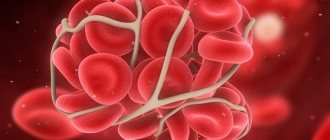What is APTT?
APTT is one of the most sensitive indicators of the blood coagulation system. In the laboratory, it is determined by the speed at which a blood clot appears after adding reagents to it - thromboplastin and calcium. A change in APTT indicates a problem in the hemostatic system and requires additional examination.
The APTT level depends on the following indicators:
- blood coagulation factors (primarily XII, XI, VIII);
- prothrombin;
- fibrinogen, etc.
An increase in APTT indicates that the blood is clotting slowly and the risk of bleeding is increased. A decrease in the indicator indicates that the blood is clotting too quickly, and thrombosis is possible.
How is the analysis carried out?
Venous blood is taken and then sent to the laboratory. Here a reagent is added to it, which in most cases is sodium citrate. This reagent eliminates clotting factors. Substances that contain an activator and phospholipids are also introduced. After some time, the blood is diluted with calcium chloride.
This process shows how well a woman’s circulatory system functions. As a result of the manipulations, a blood clot appears. Its size is assessed, after which the time it took to form this clot is calculated.
This analysis is very informative. Any deviations from the norm indicate the likelihood of bleeding. Timely treatment will help avoid bleeding during childbirth. And during pregnancy, such an analysis shows the likelihood of blood clots forming.
Indications for examination
APTT is part of the standard coagulogram. This analysis allows you to assess the state of the hemostatic system. It is prescribed twice during pregnancy:
- in the first trimester or at the first visit to the doctor;
- at 30 weeks.
Within the specified time frame, a coagulogram is prescribed to all pregnant women, regardless of the presence of complaints and chronic diseases. Additionally, APTT assessment is carried out in the following conditions:
- Unfavorable obstetric history. Previous spontaneous miscarriages, regressing pregnancy, premature birth are reasons to evaluate the coagulogram before conceiving a child. Additionally, a blood test can be prescribed in the second trimester and after 37-38 weeks.
- Pregnancy after IVF. Conception of a child usually occurs against the background of somatic and gynecological pathology, and additional control of the hemostatic system is required.
- Hereditary pathology of the blood coagulation system. Both obvious diseases (hemophilia, etc.) and previously unidentified diseases (frequent bleeding, long-term non-healing hematomas, heavy menstruation before pregnancy, etc.) are taken into account.
- Antiphospholipid syndrome is a risk factor for miscarriage in the second and third trimester.
- Complications of the current pregnancy: gestosis, placental abruption, any bleeding.
- Chronic diseases with a tendency to thrombosis (myocardial infarction, stroke, cerebrovascular accidents, varicose veins, hypertension, liver pathology, autoimmune diseases, etc.).
- Preparing for natural childbirth. A blood test is prescribed for women who are admitted to the pregnancy pathology department before their due date. Indications for hospitalization may include pregnancy complications, exacerbation of the mother's chronic pathology, or deterioration of the fetus' condition.
- Preparing for surgery. Before cesarean section and other interventions, an assessment of the hemostatic system is mandatory.
- Monitoring of drug therapy. If a woman is receiving treatment with low molecular weight heparins or other similar drugs, a follow-up examination is carried out 2 weeks after completion of the course.
Advanced blood clotting test parameters
The coagulogram can be regular or detailed. In a typical study, 4 main indicators are checked:
With an expanded coagulogram, other indicators are added. They are all interconnected. Minor fluctuations in one indicator may lead to violations of the second.
APTT (what is the norm)
APTT refers to the period required for a blood clot to form. The indicator should fall within the range of 23-35 seconds. During pregnancy, the activated partial thromboplastin time can be reduced to 17 seconds.
If the aPTT is prolonged during pregnancy, there is a risk of hypotonic bleeding, and if it is shortened, there is a risk of developing disseminated intravascular coagulation syndrome.
Fibrinogen
This is a globulin group protein involved in blood clotting.
Fibrinogen levels, which are within normal limits, are 2-4 g/l, but its amount increases to 4.8 g/l in the 2nd trimester, and by the time of birth - to 6 g/l.
With a high level of fibrinogen in the blood, there is a possibility of infections and necrotic processes in tissues.
Thrombin time
This is the time during which fibrinogen turns into fibrin, which, in turn, turns into a blood clot, completing the process of stopping bleeding.
When a cut or injury occurs, blood cells clump together to form a plug
The normal thrombin time (TT) is 11-18 seconds.
Prothrombin (prothrombin index)
The norm of prothrombin during pregnancy is 78-140%, and indicates the activity of the plasma prothrombin complex in comparison with the plasma prothrombin time. An increase in PTI signals the risk of developing placental abruption.
Prothrombin time (PTT)
This is the time during which thrombin is formed from prothrombin, which is involved in the creation of a blood clot that stops bleeding.
The normal prothrombin time for pregnant women is 14-18 seconds.
Antithrombin III
This protein prevents blood clotting. Its values should be in the range of 71-115%.
If antithrombin 3 is reduced during pregnancy, this indicates a risk of thrombosis. Also, deviations from the norm can provoke the development of placental insufficiency and spontaneous abortion.
Platelets
These blood cells are contained in a blood clot that forms in a wound during bleeding. Normal platelet counts are 150-400 thousand/µl.
The test is taken from a vein, it is better to take it in the morning on an empty stomach
A decrease in platelets signals either a decrease in their synthesis or a high level of destruction. A decrease in indicators may indicate malnutrition and the threat of developing disseminated intravascular coagulation syndrome.
International normalized ratio (INR)
INR is the calculated coagulogram value, which shows the ratio of a woman’s prothrombin time and the normal average prothrombin time. The international normalized ratio (INR) indicator allows you to monitor the state of the coagulation system if you take blood-thinning drugs (for example, the anticoagulant in the normal course of pregnancy Curantil).
Normal INR levels are 0.8-1.2. During treatment with anticoagulants – no more than 2.5.
Excessive INR values during pregnancy indicate the risk of bleeding. Decreased levels demonstrate the insufficient effectiveness of anticoagulant treatment and the danger of blood clots.
D-dimer
This indicator is responsible for the process of thrombus formation and allows for timely detection of thrombosis. D-dimer assessment is carried out both before conception (coagulogram when planning pregnancy) and during gestation.
The level of d dimer before pregnancy is 248 ng/ml, not more than 500 ng/ml. The norm during gestation depends on the trimester:
- 1st trimester – up to 750 ng/ml;
- 2nd trimester – no higher than 1000;
- 3rd trimester – no more than 1500.
Do not exercise before the test
If the d dimer value was higher than normal, this may indicate:
- diseases of the kidneys, liver and blood vessels;
- diabetes mellitus;
- late toxicosis;
- premature separation of the placenta.
Lupus anticoagulant
A group of specific antibodies that pregnant women should not have. If they are detected, this indicates autoimmune diseases and gestosis.
Lupus anticoagulant is often found in Rhesus conflict.
Soluble monomeric complexes hemostasiogram RFMK allow you to assess the degree of massive thrombus formation. The normal RVMK indicator is 3.38-4.7 mg/100 ml. During pregnancy, the rate may increase by 3 times. For example, an increased level of RFMC is observed in disseminated intravascular coagulation syndrome, when all stages of coagulation are disrupted. High levels of RFMC are characteristic of shock conditions, severe injuries, extensive thrombosis, etc.
Preparing for the examination
Rules for donating blood:
- Blood is taken from a vein.
- The blood test must be taken in the morning. You should not eat 8-14 hours before testing.
- Before the examination, it is necessary to exclude factors that may affect the result: smoking, drinking alcohol, stress, physical activity, eating fatty foods.
It is worth taking a control blood test in the same laboratory where the first study was carried out. This way you can assess the state of the hemostatic system over time and eliminate errors associated with different approaches to assessing the obtained material. When deciphering the result, you need to focus on the standards of the laboratory where the analysis was taken.
Interpretation of results
Reference values – 25-35 sec. These numbers are worth focusing on when preparing to conceive a child.
During pregnancy, the blood coagulation system is activated, and the spread of the indicator changes. There are explanations for this:
- Another circle of blood circulation is formed in a woman’s body – the placental one. The volume of circulating blood increases, the number of small vessels increases due to the placenta. Even with a slight detachment of the placenta from the wall of the uterus, heavy bleeding develops. To prevent the woman and the fetus from dying due to possible bleeding, nature provides a protective mechanism - activation of the blood coagulation system.
- During childbirth, a woman loses on average 250-400 ml of blood. This is a physiological process, but it can be dangerous for the postpartum woman. To quickly stop inevitable bleeding, blood clotting factors are activated. The closer the due date, the faster the blood clots.
During pregnancy, the aPTT level decreases gradually. By the 30-36th week it reaches 18-22 seconds. Up to 24-28 weeks it can remain within 25-30 seconds. If APTT decreases to 16-17 sec. or less, the risk of blood clots increases.
Approximate APTT normal values:
- I trimester – 27-35 seconds;
- II trimester – 24-32 seconds;
- III trimester – 18-24 sec.
A high APTT level is no less dangerous for a pregnant woman. The growth rate is above 35-40 seconds. indicates that the blood clots slowly and there is a high risk of bleeding. This condition is especially unfavorable in the third trimester - during early labor.
Reasons for deviations from the norm
Both an increase and a decrease in APTT from normal are equally dangerous. Such changes can occur for various reasons.
Increased performance
APTT is elevated when clotting time exceeds 40 seconds. In this case, the ability to form blood clots is reduced, but there is a high probability of bleeding. This condition can occur due to the use of antibacterial, thrombolytic and some other groups of drugs. Therefore, if such drugs were taken without the knowledge of the doctor, he must be informed about this. Otherwise, incorrect results may be obtained.
Some pathologies can also lead to an increase in APTT:
- Liver diseases in which severe liver failure occurs. This condition can occur with cirrhosis and hepatitis. There is a disruption in the synthesis of coagulation factors found in the blood.
- Hemophilia. This is a hereditary disease that occurs predominantly in men. Blood factor deficiency is congenital and cannot be treated. Therefore, spontaneous bleeding may occur, which is very difficult to stop.
- Lack of vitamin K in the body. This occurs due to a disruption in the process of its production in the intestines. This can be caused by dysbacteriosis, poor nutrition and other factors.
- Von Willebrand's disease. This is an inherited disease in which the protein that transports clotting factors is not produced.
- Leukemia.
- Deficiency of coagulation factors.
All of the above conditions are very dangerous during pregnancy and require immediate treatment. Otherwise, bleeding may occur. Sometimes they are so strong that they pose a threat to a woman’s life.
Decreased performance
If the aPTT level decreases, there is a high probability of blood clots. This is very dangerous, as it can lead to damage to blood vessels and oxygen starvation of the mother and fetus. And the rupture of a blood clot can lead to a stroke and even death.
APTT is reduced if the time of thrombus formation is less than 17 seconds. This may occur due to the following reasons:
- Past inflammatory diseases. Bacteria and viruses can damage the walls of blood vessels, causing them to not perform their functions normally.
- With DIC syndrome. During the first phase, the process of thrombus formation accelerates.
- In case of large blood losses, before taking tests. As a result, to restore blood volume, it is produced in increased quantities, and its coagulability decreases because of this. It is not recommended to become a blood donor during pregnancy.
- The presence of malignant neoplasms. They can also lead to damage to the vascular walls.
Additional research may be needed to find out the exact cause. The doctor must determine why the APTT decreases and prescribe competent treatment. Otherwise, there is a high probability of developing some complications.
During pregnancy, you need to regularly take various blood tests to look at certain indicators. The APTT test is very important because it shows how quickly the blood clots. During pregnancy, this plays an important role. Finding this indicator normal guarantees normal delivery without the risk of uterine bleeding.
Increased APTT
An increase in APTT occurs in the following conditions:
- congenital pathology of the blood coagulation system (hemophilia, von Willebrand disease, etc.);
- late phases of DIC syndrome (II and III), when reserves of coagulation factors are depleted and bleeding occurs;
- antiphospholipid syndrome;
- autoimmune diseases;
- severe liver pathology (the synthesis of blood clotting factors is disrupted with significant damage to the organ);
- severe renal dysfunction;
- malignant blood tumors (leukemia);
- irrational therapy with heparins (the treatment regimen needs to be reconsidered).
An increase in aPTT may be the result of an error when drawing blood (if the tube was not completely filled).
Decreased APTT
A drop in APTT indicates the following conditions:
- gestosis with a high risk of developing preeclampsia and eclampsia;
- early phase of DIC, when increased blood clotting occurs;
- severe infectious diseases and inflammatory processes;
- blood loss before donating blood for analysis;
- malignant neoplasms.
A decrease in the indicator may be due to a violation of the blood sampling technique. If a blood clot that occurs during venipuncture gets into the tube, the aPTT will decrease.
Tactics for changing APTT
The APTT level should be assessed in conjunction with other indicators of the hemostatic system:
- fibrinogen;
- lupus anticoagulant;
- prothrombin;
- thrombin time.
If abnormalities in the coagulogram are detected, an extended blood test for coagulation is prescribed - hemostasiogram. According to indications, an ultrasound of internal organs is performed. A consultation with a therapist, hemostasiologist and other specialists is indicated, taking into account the identified pathology. Further tactics will depend on the results of the examination, the condition of the woman and the fetus.
How to prepare and donate blood for a coagulogram?
It is customary to donate blood for a coagulogram 3 times during pregnancy:
- during registration;
- at 22-24 weeks;
- at 30-36 weeks.
If necessary, unscheduled blood donation is carried out:
- infertility prior to pregnancy;
- previous miscarriage;
- presence of complications;
- phlebeurysm;
- increased bleeding;
- long-term therapy with anticoagulants.









